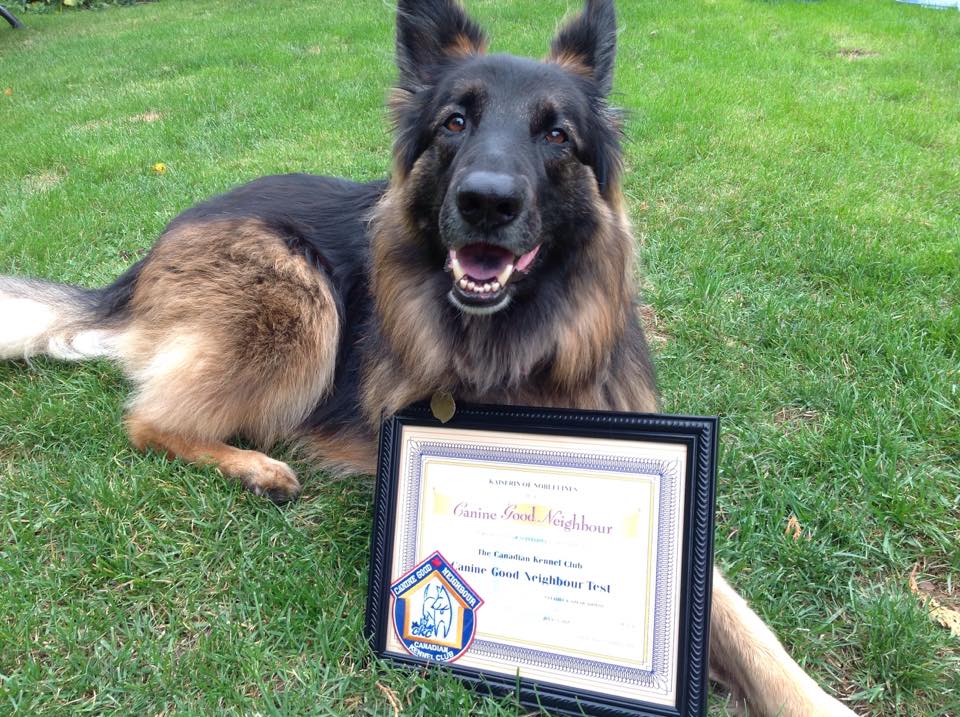Natasha and Kaiserin


So I got a German Shepherd/Labrador Retriever mix named Empress. She was the most mellow dog, loved everyone, was always calm and rarely barked. She also had hip dysplasia at 9 months old so wasn’t ever very active. We had 13 wonderful and stress free years together.
Then in 2011, I decided it was time for my dream dog. I mean I was now an experienced dog owner right? Along came Kaiserin, a 9-week old purebred long -haired German Shepherd. She has proven to be so incredibly affectionate and intelligent from the very moment I got her. But, right away, it was also pretty clear she was going to be very different from my first dog.
From day one, she was go, go, go all day. She got up in the morning and gave me a look as if to say “so what are we going to do today?” If I didn’t find her a “job” or something to do, she decided on one for herself and it was usually something loud or destructive. One day the couch “stole” her ball and since she couldn’t get it out from underneath, she decided to chew a hole through it. It became clear very quickly that this was a dog that needed a lot more training.
[embed_video link=https://www.facebook.com/natasha.baguley.7/videos/10153626417666745/]
What I didn’t like though was people telling me that you have to run your dog to exhaustion so that they were basically too tired to cause trouble. This seemed wrong to me and after having one dog with joint issues and an awareness of the dangers of over exercising a young dog, I knew I had to find a better approach. Instead I decided I needed to teach her things. After all, this is a working breed used by police, military and drug enforcement. How could I expect her to sit on the couch all day watching me on the computer.
We went to obedience classes and I took her to her first obedience trial at around a year old. She learnt fast. We started to do some agility classes for fun and I bought a book of 101 dog tricks and started teaching them to her one by one. She didn’t know they were tricks. To her, these were things she had to do and I believe taught her that she needed to be looking to me for direction (rather than deciding on her own what to do). It seemed I could teach her anything.
I taught her how to paint by holding a brush and touching it to a canvas, how to be a soccer goalie and how to bring me specific objects from a pile. I watched a video on treiball and taught her to push a ball into a net. I recently discovered scent work through the Sport Dog Training Centre and it has given her something else positive to focus on and is something she really seems to enjoy. I was amazed at our first scent trial how focused she was, especially since we developed a new issue we are still working on overcoming.
You see, I had this wonderful dog that learnt so much and was an absolute angel in the house. The problems occurred as we continued to try to interact with the world. What I wasn’t prepared for was the prejudice that exists towards dogs of certain breeds. My shepherd/lab cross looked very happy, approachable, friendly. Kaiserin looks very intimidating with a dark face and an intense stare. When she was young, she was the cutest, fluffiest puppy and people would run over to see her from across the street. I even had a couple of people stop their cars and ask if they could get out and see the puppy.
As she got bigger, she was gangly with big ears and big feet and still drew a lot of positive attention. Then just after a year of age, when she hit 90 pounds, attitudes changed. People crossed the street to avoid us. They pulled away their dogs and children like I had some kind of monster on the other end of the leash. The problem was that Kaiserin was still the same puppy inside. She loved people and attention from them.
She loved to see other dogs. But when people looked scared, I now pulled her away. When she saw a person or dog she couldn’t get to, she fought the leash and lunged towards them, just wanting to say hello. Nobody wanted to say hello anymore. I started holding her tightly when people passed. I now realize tightening a leash like that is a very bad plan. I saw her getting frustrated. After a few more months, she started barking as well as lunging. I held on tighter and dragged her past the other dogs amidst a barking fit, telling her no. Then a few months later, she added an occasional growl. I created a very bad habit and a 2 year old dog with a case of leash frustration/aggression.
To this day she is still fine off a leash. I can take her to the dog park and she runs around greeting all the dogs and humans, happy as can be. But the minute the leash is on, she doesn’t like the restriction. I look back now and see exactly how the problem evolved. If I could do it all over, I would have used positive reinforcement and distraction to make sure leash walking was always a positive experience. At almost 5 years old and after some behaviour modification work, she is much better. Leash walking can still sometimes be a challenge though.
So my two pieces of advice to anyone considering a German Shepherd (or other large working breed) is to make sure you have time to devote to activities that stimulate their minds. And don’t feel like it is a chore because these activities are all actually lots of fun. My second piece of advice it to be aware that people are going to be scared of your dog, adjust your training accordingly, and find a trainer who understands the issues specifically related to these dogs.
I always wanted a German Shepherd, mostly because I think they are the most beautiful dog around but also because they are strong and noble, loyal, intelligent and protective. In the late 1990s, I spoke to a breeder who told me a German Shepherd maybe wasn’t the best first dog because they really required a lot of work and training.
 So I got a German Shepherd/Labrador Retriever mix named Empress. She was the most mellow dog, loved everyone, was always calm and rarely barked. She also had hip dysplasia at 9 months old so wasn’t ever very active. We had 13 wonderful and stress free years together.
So I got a German Shepherd/Labrador Retriever mix named Empress. She was the most mellow dog, loved everyone, was always calm and rarely barked. She also had hip dysplasia at 9 months old so wasn’t ever very active. We had 13 wonderful and stress free years together.
Then in 2011, I decided it was time for my dream dog. I mean I was now an experienced dog owner right? Along came Kaiserin, a 9-week old purebred long -haired German Shepherd. She has proven to be so incredibly affectionate and intelligent from the very moment I got her. But, right away, it was also pretty clear she was going to be very different from my first dog. From day one, she was go, go, go all day. She got up in the morning and gave me a look as if to say “so what are we going to do today?” If I didn’t find her a “job” or something to do, she decided on one for herself and it was usually something loud or destructive. One day the couch “stole” her ball and since she couldn’t get it out from underneath, she decided to chew a hole through it. It became clear very quickly that this was a dog that needed a lot more training.
What I didn’t like though was people telling me that you have to run your dog to exhaustion so that they were basically too tired to cause trouble. This seemed wrong to me and after having one dog with joint issues and an awareness of the dangers of over exercising a young dog, I knew I had to find a better approach. Instead I decided I needed to teach her things. After all, this is a working breed used by police, military and drug enforcement. How could I expect her to sit on the couch all day watching me on the computer.
We went to obedience classes and I took her to her first obedience trial at around a year old. She learnt fast. We started to do some agility classes for fun and I bought a book of 101 dog tricks and started teaching them to her one by one. She didn’t know they were tricks. To her, these were things she had to do and I believe taught her that she needed to be looking to me for direction (rather than deciding on her own what to do). It seemed I could teach her anything.
I taught her how to paint by holding a brush and touching it to a canvas, how to be a 
You see, I had this wonderful dog that learnt so much and was an absolute angel in the house. The problems occurred as we continued to try to interact with the world. What I wasn’t prepared for was the prejudice that exists towards dogs of certain breeds. My shepherd/lab cross looked very happy, approachable, friendly. Kaiserin looks very intimidating with a dark face and an intense stare. When she was young, she was the cutest, fluffiest puppy and people would run over to see her from across the street. I even had a couple of people stop their cars and ask if they could get out and see the puppy. As she got bigger, she was gangly with big ears and big feet and still drew a lot of positive attention.
Then just after a year of age, when she hit 90 pounds, attitudes changed. People crossed the street to avoid us. They pulled away their dogs and children like I had some kind of monster on the other end of the leash. The problem was that Kaiserin was still the same puppy inside. She loved people and attention from them.
She loved to see other dogs. But when people looked scared, I now pulled her away. When she saw a person or dog she couldn’t get to, she fought the leash and lunged towards them, just wanting to say hello. Nobody wanted to say hello anymore. I started holding her tightly when people passed. I now realize tightening a leash like that is a very bad plan. I saw her getting frustrated.
After a few more months, she started barking as well as lunging. I held on tighter and dragged her past the other dogs amidst a barking fit, telling her no. Then a few months later, she added an occasional growl. I created a very bad habit and a 2 year old dog with a case of leash frustration/aggression.
To this day she is still fine off a leash. I can take her to the dog park and she runs around greeting all the dogs and humans, happy as can be. But the minute the leash is on, she doesn’t like the restriction. I look back now and see exactly how the problem evolved. If I could do it all over, I would have used positive reinforcement and distraction to make sure leash walking was always a positive experience. At almost 5 years old and after some behaviour modification work, she is much better. Leash walking can still sometimes be a challenge though.

